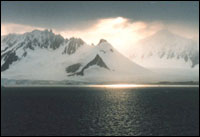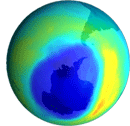From just about anywhere you are on the planet, the city of Punta Arenas, Chile, is very, very far away. Perched on the banks of the Strait of Magellan, Punta Arenas is bounded on the north by the ice fields of Patagonia, a place that the combined forces of nature and the outdoor-gear industry have made synonymous with all things rugged and remote. To the south, on the other side of the strait, the Western Hemisphere peters off into the fractured islands of Tierra del Fuego; beyond that lies the Antarctic. And then there is another, newer landmark: For a few months every year, during the Southern Hemisphere spring, Punta Arenas sits directly beneath the hole in the ozone layer.

Indecent exposure: sailing out from Punta Arenas.
Photo: NOAA.
I lived in Chile a few years ago and spent some time in Punta Arenas, a town of about 120,000, not counting sheep or tourists. This was in 2000, when the ozone hole was at its largest ever — 11.5 million square miles, bigger than Canada and Russia combined. The ultraviolet light leaking through that hole posed significant health threats to residents of Punta Arenas: increased risk of severe sunburns, skin cancer, weakened immune systems, and cataracts and other vision problems, to name a few.
Despite the magnitude of the problem and the attendant health concerns, the people of Punta Arenas had reason for cautious optimism back in 2000. If they had the misfortune to be among those most directly afflicted by the depletion of the ozone layer, at least the global community was making a good-faith effort to resolve their predicament, thanks to the Montreal Protocol, often considered the most successful international environmental treaty ever negotiated.
Well, sic transit gloria mundi. Last week, at a meeting at the headquarters of the United Nations Environment Program in Nairobi, Kenya, the United States demanded an exemption from a Montreal Protocol requirement to phase out the use of methyl bromide by 2005. Methyl bromide is a deeply toxic pesticide that destroys ozone at 45 times the rate of chlorine, the better-known bad guy in the ozone-hole drama. (Chlorine is the insidious ingredient in chlorofluorocarbons, or CFCs.) According to the protocol, which took effect in 1987 and boasts more than 160 signatories, developed nations must cut their methyl bromide use 70 percent compared to 1991 levels by this year and phase it out entirely by 2005. Under previous administrations, the U.S. complied with the first part of that requirement — but in Nairobi, instead of going the last mile, the Bush administration demanded permission to increase U.S. use of methyl bromide to 38.2 percent of 1991 levels in 2005 and 37 percent in 2006.
The good news is that the European Union and the developing world wouldn’t stand for it. The bad news is that I can’t find an iota of evidence that the Bush administration gives a damn what the rest of the world stands for. Witness the Nairobi meeting: Slated as a routine check-in to assess and adjust the treaty’s efficacy in repairing the ozone layer, it was commandeered by the U.S. and turned into a forum for undoing more than 15 years of steady progress toward that goal. Flummoxed by the American delegation’s insistence on violating the terms of the treaty (and, incidentally, of the federal Clean Air Act), the negotiators agreed to revisit the issue in an “extraordinary meeting” to be held in Montreal in March — the first time in the history of the protocol such a meeting has been necessary.

Strawberry short cuts.
Photo: USDA.
Extraordinary indeed. What is the Bush administration thinking? Well, this administration has a one-track mind, so that question is answered easily enough: It’s thinking about its campaign donors. Methyl bromide is the fumigant of choice for growing, storing, and shipping many agricultural products, notably strawberries, tomatoes, ginger, sweet potatoes, and turf grass (the stuff used on golf courses). It’s also the favored substance for fumigating agricultural imports to destroy any invasive species that might have come along for the ride. (Because of that use, the White House has billed its support of methyl bromide as good for the environment, but enviros aren’t buying it.) Both methyl bromide manufacturers and agribusiness have donated generously to the Bush campaign, as journalist Glenn Scherer documented in an August Salon article. Thus the backtracking on the Montreal Protocol shares the same politico-pecuniary motivation as every other environmental rollback on this administration’s record, notably its withdrawal from the Kyoto treaty on climate change.
But in meddling with the Montreal Protocol, the Bush administration may have overreached. It’s one thing to stonewall about addressing a complicated issue (climate change) involving the single most important commodity of modern life (energy). It’s another thing to deliberately undo years of demonstrable progress on a well-known issue in order to curry favor with an industry that has had years to come up with safer alternatives. If the other countries of the world stand strong in March, environmentalists should be looking at a win-win situation. Either the Bush administration will have to suck it up, abide by the methyl bromide restrictions, and acknowledge that it overstepped this time — or it will have to walk away from the treaty entirely, thereby presenting the environmental movement (and the entire progressive community) with a prime opportunity for pillorying.

Ozoning out.
Image: NASA.
Think about it: Not so long ago, the ozone hole was, like pandas and rainforests, a cause celebre. Its popularity as an issue reached well beyond the earnest environmental crowd; junior high kids learned about it in science classes and people who once hadn’t known a CFC from a CFO fretted about it with their friends. If the U.S. walks away from the negotiating table in March, a little concerted effort could put the issue front and center again — at a most awkward moment for a would-be two-term president.
So here’s a little messaging, conveniently prepackaged for progressive spin doctors (hello, anybody out there?): This tough-talking, warmongering administration is actually the wussiest White House in history. There is not a single moneyed interest, no matter how comparably shallow its pockets or craven its intentions, for which the Bush administration will not roll over and play ethically dead. Any day now, we can expect the president to renege on the CFC commitments of the Montreal Protocol, too — anything for his friends in the hairspray industry, you see.
Three years ago, the mayor of Punta Arenas, Juan Enrique Morano Cornejo, succinctly summarized the effects on the hoi polloi of this kind of politicking. “Around here,” he told me, “we call it the Ley del Gallinero” — the law of the chicken coop. The law of the chicken coop turns out to be a lot like the law of gravity: Things fall downward, and for the chickens at the bottom of the coop, life is, well, kind of shitty.
The hole in the ozone layer was the problem that taught us about planetary interdependence — about the uncanny proximity of places like Punta Arenas to the rest of the world, no matter how far away they may seem on a map — long before climate change or globalization became household terms. The progress that we’ve made toward repairing that hole demonstrates the amazing power of international collaboration and commitment. If the Bush administration succeeds in backing out of that commitment, it will represent an act of moral disemboweling: spineless, gutless, visionless, heartless. And, of course, brainless: Chickens, it should be remembered, have a way of coming home to roost.
— Kathryn Schulz, managing editor
